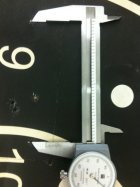Friends of mine that shoot 1000 yards with me are trying to use the 284 Winchester cartridge with Berger 180 grain hybrids and 175 Sierra MK's. They shoot great, but all seem to have 1 or 2 out the bottom of the groups (in the 8 ring) in a 20 shot string. They are about to give up due to this vertical problem.
They are shooting with Lapua or Winchester cases, BR-2 primers and +/- 54.5 grains of H4831SC with 175-180 grain bullets with BAT actions and Krieger barrels in the 30"-32" lengths in professionally built guns.
They swear that their ES's are in the 20 fps range, but it seems to me that the lows are due to the rounds having lower velocity outside of 20 fps. Possibly incomplete ignition and a LRM primer may cure?
Ideas of the cause and cure? The reason I ask is: one, I would like to help them as I think the resolution is something simple; and, two, that I am having a 284 built for 1000 yards and these different shooters experiencing consistent low shots is worrying me. I have bulelts, cases, dies and powder (H4831SC) bought and awaiting the gun.
Thanks,
George
They are shooting with Lapua or Winchester cases, BR-2 primers and +/- 54.5 grains of H4831SC with 175-180 grain bullets with BAT actions and Krieger barrels in the 30"-32" lengths in professionally built guns.
They swear that their ES's are in the 20 fps range, but it seems to me that the lows are due to the rounds having lower velocity outside of 20 fps. Possibly incomplete ignition and a LRM primer may cure?
Ideas of the cause and cure? The reason I ask is: one, I would like to help them as I think the resolution is something simple; and, two, that I am having a 284 built for 1000 yards and these different shooters experiencing consistent low shots is worrying me. I have bulelts, cases, dies and powder (H4831SC) bought and awaiting the gun.
Thanks,
George











